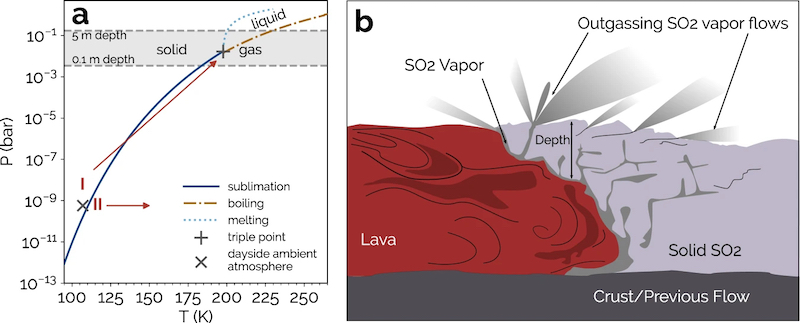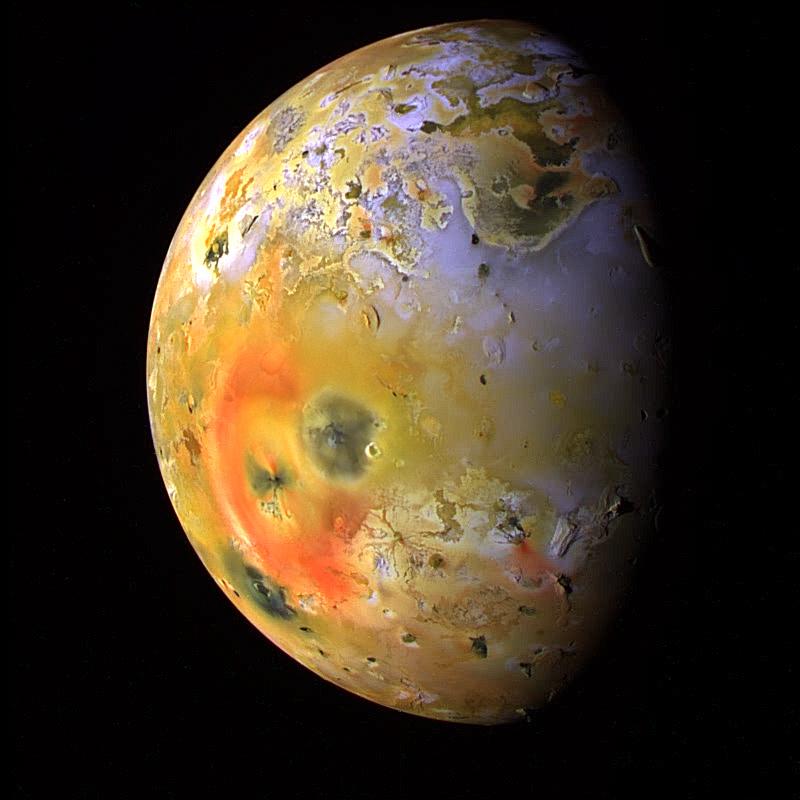
Io’s enigmatic dunes
We find dunes in the deserts of Earth and Mars. Saturn’s moon Titan has dunes. Even Pluto has dunes, composed of methane ice. And Jupiter’s moon Io – the most volcanically active world in our solar system – also has long, dune-like ridges on its surface. Io’s atmosphere is thin. Its winds are too weak to form dunes in the ordinary way. But on April 19, 2022, researchers at Rutgers said they can explain Io’s dunes, with the help of lava from Io’s volcanos and frost below the moon’s surface. One of the researchers commented:
This work tells us that the environments in which dunes are found are considerably more varied than the classical, endless desert landscapes on parts of Earth or on the fictional planet Arrakis in Dune.
The researchers published their peer-reviewed study in Nature Communications on April 19, 2022.
Is Io a dune world?
Scientists have known about Io’s possible dunes – also referred to as ridges – since NASA’s Galileo spacecraft first saw them in the late 90s. They are long and meandering, reminiscent of dunes on Earth or Mars. But how could these features really be dunes, since Io’s atmosphere, mostly sulfur dioxide, is so thin? On planets like Earth and Mars, dunes require wind to form.
The new study, however, shows how dunes could indeed form on Io from moving sand grains. This is a process known as aeolian transport. As lead author George McDonald at Rutgers stated:
Our studies point to the possibility of Io as a new ‘dune world.’ We have proposed, and quantitatively tested, a mechanism by which sand grains can move, and in turn dunes could be forming there.


How do Io’s dunes form?
So how did the researchers figure out the formation process of Io’s dunes? Io is a volcanic world, with a surface of dark solidified lava flows and snow or frost of sulfur dioxide (SO2). Sand-like grains of these materials form the dunes. The researchers used mathematical equations to calculate how a single grain would be transported in Io’s weak winds.
They found something surprising, however. The grains could move faster and more efficiently by additional venting. This happens when lava flows into and interacts with sulfur dioxide frost beneath Io’s surface. This creates venting, or outgassing, of vapor flows. As explained in the paper:
Here we demonstrate that wind-blown transport of sediment may also be altering the Ionian surface. Specifically, shallow subsurface interactions between lava and Io’s widespread sulfur dioxide (SO2) frost can produce localized sublimation vapor flows with sufficient gas densities to enable particle saltation.

According to McDonald, the venting is:
… dense and fast moving enough to move grains on Io and possibly enables the formation of large-scale features like dunes.
So it would seem that Io’s volcanism, which makes the moon look like a giant colorful pizza, also helps to create its dunes.
Old photos hold clues to Io’s enigmatic dunes
Additional clues about Io’s dunes come from Galileo images. Indeed, the structure of the ridges themselves – spacing of crests and height-to-width ratios – are consistent with dunes on Earth and elsewhere. From the paper:
Finally we make the first measurements of the dimensions of linear features in images from the Galileo probe, previously termed ‘ridges,’ which demonstrate certain similarities to dunes on other planetary bodies. Io joins a growing list of bodies with tenuous and transient atmospheres where aeolian sediment transport may be an important control on the landscape.

As co-author Lujendra Ojha at Rutgers said:
Work like this really allows us to understand how the cosmos works. In the end, in planetary science, that is what we are trying to do.
Io has over 400 known active volcanoes, and its surface is continuously being painted with lava flows and particles from volcanic plumes. It is the innermost and 3rd-largest of the four Galilean moons of Jupiter. Io’s intense volcanism is the result of tidal heating of its interior by Jupiter’s strong gravitational pull. Io also has the highest density and strongest surface gravity of any moon in the solar system.
Bottom line: Researchers at Rutgers say they can finally explain how Io’s enigmatic dunes form, despite the moon’s extremely thin atmosphere and weak winds. Venting from volcanic lava flows can help transport sand grains and create the dunes.
Source: Aeolian sediment transport on Io from lava–frost interactions











